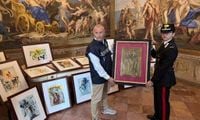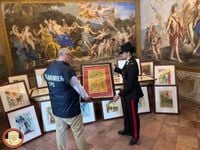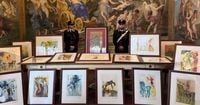On October 1, 2025, the tranquil halls of Parma’s Palazzo Tarasconi were disrupted by a swift intervention from Italy’s art police, who seized 21 artworks attributed to the legendary surrealist Salvador Dalí. The dramatic operation, reported by multiple outlets including the Associated Press and The Art Newspaper, sent shockwaves through the Italian art world and underscored the persistent threat of art forgery that haunts even the most celebrated names in modern art.
The seized works, a mix of tapestries, drawings, and engravings, were part of the exhibition “Salvador Dalí, tra arte e mito” (“Salvador Dalí, between art and myth”). This traveling show had previously graced Rome’s Historical Museum of the Italian Army Infantry from January to July 2025 before opening in Parma on September 27. According to ArtNews, Dalí’s whimsical and instantly recognizable creations make him a perennial target for forgers, placing him alongside Pablo Picasso and Amadeo Modigliani as one of the most frequently counterfeited artists in history.
The operation was set in motion months before, as detailed by The Art Newspaper. During a routine check in January, Italy’s Carabinieri TPC art squad noticed something odd: the exhibition featured only lithographs, posters, and drawings—no paintings or high-value works. “Something seemed amiss,” Diego Polio, commander of the Carabinieri TPC’s Rome branch, told Italy’s Radio Bruno. “It was difficult to understand why someone would want to organise an exhibition of such low-value works.”
Suspicions deepened in February when the Carabinieri sent a catalogue of the exhibition to the Gala-Salvador Dalí Foundation in Figueres, Spain. The foundation, established by Dalí himself in 1983 to “promote, foster, disseminate, enhance, and defend Dalí’s world worldwide,” hadn’t been consulted about the show. In March, the foundation issued a report expressing “strong perplexity” about the provenance of several works, specifically highlighting doubts about three drawings and a series of prints. Their experts later visited the exhibition in Rome to investigate further.
With these mounting concerns, the Carabinieri waited for the exhibition to relocate to Parma before making their move. Acting on a judge’s warrant, they seized the 21 suspect works—18 lithographs and three drawings, all on loan from two Italian individuals. As The Art Newspaper and AP noted, police emphasized that the investigation is ongoing and that preliminary inquiries do not imply guilt. The next phase will see culture ministry officials conduct a thorough inspection to determine the authenticity of the works. If confirmed as fakes, the items may be permanently confiscated, and those responsible could face prosecution for forgery or knowingly dealing with counterfeits.
Diego Polio explained to The Guardian that the authorities are keen to establish whether the counterfeiting was done by the exhibitors themselves or if they unwittingly purchased forged works from others. “Now it is a matter of understanding whether the works were counterfeited directly by the people who put them into circulation, or whether the people who put them into circulation purchased them from others,” said Stefano Opilio, a public prosecutor in Rome involved in the investigation.
The exhibition’s organizers, the Palermo-based Navigare company, have pledged full cooperation with the authorities. Salvatore Lacagnina, Navigare’s exhibition organizer, told ANSA that the show in Parma would continue as planned, minus the 21 seized works. Out of the original 120 pieces on display, the remaining items are still available for public viewing, though the cloud of suspicion inevitably hangs over the entire event. Navigare has also postponed a planned photography exhibition in Milan dedicated to Frida Kahlo as a direct result of the ongoing investigation.
The scandal has drawn attention to the broader issue of art fraud in Italy and across Europe. As reported by Devdiscourse, the Carabinieri’s art heritage police have previously uncovered a network forging works by modern masters such as Banksy, Picasso, Warhol, and Dalí. In February 2025, the TPC police discovered an art forgery workshop in Rome, where paintings by Rembrandt and Picasso were being replicated and sold on eBay. These incidents highlight the sophisticated, international nature of art forgery rings and the significant resources required to combat them.
For the Gala-Salvador Dalí Foundation, the case is a stark reminder of the challenges faced in protecting the artist’s legacy. The foundation, headquartered in Figueres, has long been vigilant in its mission to authenticate Dalí’s works and safeguard his reputation. In a statement to The Art Newspaper, the foundation confirmed, “From the moment the content of this exhibition...became known, the Dalí Foundation expressed its doubts to the Carabinieri regarding three drawings and a series of prints.” Their proactive stance was instrumental in triggering the police action.
While the investigation continues, the art world is left grappling with uncomfortable questions. How can galleries and museums ensure the authenticity of the works they exhibit? What responsibilities do organizers have in verifying provenance before mounting major shows? And, perhaps most pressingly, how can collectors and the public trust what they see on the walls?
For now, the authorities are urging caution. As the Carabinieri stressed in their official note, preliminary investigations do not imply guilt. The outcome will depend on expert analysis and the legal process, which may take months to unfold. Meanwhile, the seized works will remain in the custody of the culture ministry, awaiting their final verdict.
Despite the drama, the exhibition in Parma remains open, albeit with a reduced collection. Visitors continue to flock to Palazzo Tarasconi, drawn by the enduring allure of Dalí’s surreal vision—even as the authenticity of some pieces is called into question. The episode serves as a potent reminder that in the world of art, appearances can be deceiving, and vigilance is always in order.
As Italy’s art police and Dalí’s foundation press forward with their investigation, the art community—and the public at large—wait for answers, hoping that truth and authenticity will ultimately prevail.


